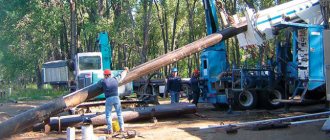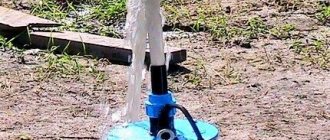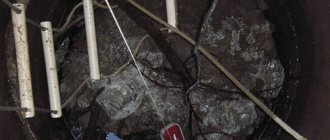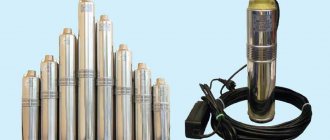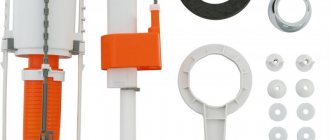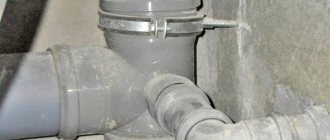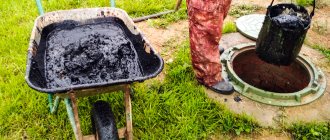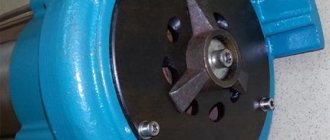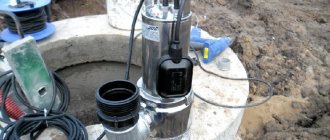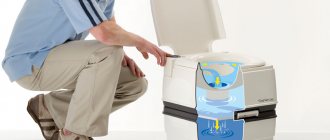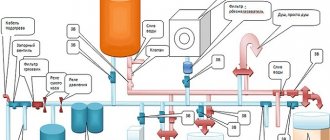The trunk and equipment of a private water source tend to gradually wear out. To restore the technical condition, it is not necessary to resort to the services of hired workers; the well owner can repair the well with his own hands. But first you should familiarize yourself with the methods of resuscitating the source. Isn't it true?
Here you will find valuable recommendations and descriptions of important nuances that ensure success in correcting the condition of the workings. We have described in detail the options for carrying out repair work and the technologies for their implementation. The information we provide is based on building regulations and the experience of owners of sites with wells.
The article examines in detail all possible causes of violations in the operation of an autonomous water intake structure. Methods for cleaning the source are described and a method for replacing the casing is outlined. Photo and video applications are provided as excellent additions to illustrate the topic.
Device
- Casing. Serves as a sleeve for installing pumping equipment. Made from metal, plastic and polyethylene pipes. Each section is fastened together with a threaded connection or a weld.
- Bottom filter. It is located at the very bottom and protects the water layer from silt or soil entering the trunk.
- A filtration layer of large pebbles is poured along the entire length of the aquifer. To make a pie - soil, a layer of pebbles or crushed stone, casing.
- A chamber or well is constructed in the upper part of the well for installation of equipment and unhindered access to shaft maintenance. The well must be installed to the depth of soil freezing in order to protect the source from the cold in winter.
- Pumping equipment is located inside the upper chamber or in a remote room, but is also part of the aquifer well.
- Pipeline for supplying water to the filtration system and beyond.
- Coarse and fine filters. They are installed after the pump and are the last barrier for small particles before delivery to the consumer.
Important information about the well filter
When cleaning the well, it is important to be careful, otherwise you can accidentally destroy the filter, especially if water hammer is used. If the filter was cleaned with chemicals, the water quality will inevitably deteriorate. Don't worry. This is a temporary phenomenon.
Gradually, the well will be cleared of chemicals, and the water will again become of high quality. To prevent the reagents from having a negative impact on health, you should pump water from the well for 12 hours and stop using it for domestic purposes for a couple of days. You should also install good filters in your home and not use unfiltered water for drinking or cooking until it is purified.
When chemically cleaning a well filter, substances are used that are used in the food industry, so it is generally accepted that they are safe. However, you should always keep the quantity in mind. The concentration of chemicals in the water after cleaning is too high. Reasonable precautions must be taken to avoid poisoning.
The initial purification of groundwater from mineral particles is carried out by a well filter. It is arranged throughout the entire thickness of the aquifer plus half a meter above and below (+)
In addition to chemical filter cleaning, you can use mechanical cleaning. This method is safe and does not affect water quality. To clean the filter from deposits, use a metal device that looks like a regular bottle brush, but is much larger.
Simultaneously with the brush, you can also use cleaning by pumping water. But you should always be aware of the risks. The filter may not withstand the additional pressure and may collapse. It's better not to experiment unless absolutely necessary.
What malfunctions can there be
Earth layers at a depth of 20 meters are in constant motion. The shaft passes through three or four layers and is a foreign object in the earth's crust. Therefore, during natural movement, the trunk is constantly exposed to pressure from different sides and at different depths. Types of faults:
- A sharp or gradual decrease in the flow rate of the source. This happens when sand or silt gets into the water. The pump cannot cope with the thick fraction and becomes clogged. The water supply stops or comes in jerks with dirt. Fluid supply equipment is broken. Lowering the water level in the barrel, the pump is located higher.
- Violation of tightness in the places where pipes connect to each other. Due to improper installation or during long-term operation of the well, actual depressurization of the joints occurs. High water rushes into the cracks, carrying soil deposits with it. The result is a mixing of drinking water and groundwater with sand and clay.
- Broken deep well pump. Failure of water supply equipment to the surface during constant and long-term use of water resources.
- Failure of the filter at the bottom of the source. The breakdown is one of the most difficult in terms of well reconstruction. Large and small stones getting into the filter mesh, silting, partial and complete destruction.
- Displacement of pipe axes due to improper installation or operation in difficult geological conditions. As a result of the movement of layers, coaxiality is lost in them. Separation of components from each other with loss of tightness and violation of the integrity of the shaft leads to a narrowing of the diameter and gradual clogging of the well.
- Poor quality of drilling and installation of the source and equipment. Poor qualifications of workers carrying out work with the casing entail inevitable problems and breakdowns during operation. This is most often associated with an attempt to save money and hire cheaper labor.
- Siltation, sand getting into the mine. The blockage occurs gradually, so diagnosing the problem is difficult. Detection occurs when the pump is completely immersed in the ground and it will be more difficult to get it out.
- Aquifer depletion. Drilling is carried out after geological exploration, during which the depths of water horizons are revealed. During drilling, when passing through several layers, workers must take measures to sufficiently separate each layer from each other to avoid mixing of water layers. Otherwise, the vein will dry out - the liquid will go into the voids below the level.
- Broken deep-well pump support cable. A submersible apparatus is used as a tool for supplying water; the cause of the malfunction may be a break in the suspended equipment. The cable broke and the device fell to the bottom, without necessarily disconnecting the hose. Its elasticity allows the hose to stretch up to a distance of one meter.
- Formation of holes in the liner due to destruction from corrosion or the appearance of holes from impacts. There can be a lot of them along the entire length of the sleeve, especially if the source is not new. This happens due to the aggressive environment in which the trunk is located. Constantly hitting the shaft housing with a pump when lifting it for cleaning can lead to the formation of holes.
- Plaque on the walls of the trunk. Complex chemical processes are constantly occurring in the well. The result of mixing various elements is the formation of limescale on the pipe walls.
When is the best time to drill a new well?
If problems become frequent, the supply system works intermittently, and the flow rate is steadily decreasing, you should think about creating a new permanent source. There are a number of violations that cannot be eliminated, and most of them are related to the arrangement of the filter:
- improper installation (past the aquifer);
- when selecting a grid, the fraction of aquifer sand is not taken into account;
- gravel barrier not installed;
- installation of low-quality mesh that allows sanding.
If the mine design does not allow the replacement of internal mechanisms, the listed factors automatically become the reason for the conservation of the source. You can install additional mesh devices or perform weekly resuscitation, but productivity will still constantly decrease.
In these cases, it is easier to make a new well than to revive an old one:
- Trunk displacement. Occurs if the pipes were clogged incorrectly;
- The soil layer has become depleted. Sometimes the water disappears after prolonged use;
- Asbestos pipes were used in the construction. Over time, they become fragile and cannot be removed to replace them.
Keep in mind that the Abyssinian version is installed for a limited period - up to 7 years, so it is also customary not to repair it, but to close it after its service life has expired. Each recovery attempt will only prolong the work by 2-3 months.
Remember that the old well must be sealed to prevent contaminants from reaching the source.
In these cases it will not be possible to repair
Errors that were made during drilling that affect the quality of the source in the future include the following:
- the wrong height for installing the mesh filter was chosen - the water layer is located below the mesh and the walls block it from entering the trunk;
- drilling was carried out without exploration and stopped in the upper layers, where a small amount of water resources is concentrated;
- there is no gravel filter filling the lower layers of the mine.
Important: the company that carried out the drilling work is required to provide a guarantee for the use of the source for a period of up to five years.
We determine the location and repair it ourselves
Symptoms: the liquid has changed color or taste.
The composition contains impurities of silt or sand, and a persistent swamp smell has appeared.
Diagnostics
The reason for the incorrect operation of the source is a violation of the tightness at the pipe joints. Mixing of perched water and drinking water occurs. Dirty liquid, silt or sand leaks through cracks, crevices, and pipe openings. The filter does not cope with its duties - small particles enter the pump and are sent to the water supply system. Holes appeared in the barrel as a result of corrosion or an impact on the cartridge case.
What to do
Templating, identifying the location of a hole or gap. Special equipment is immersed into the shaft to determine the depth and size of the hole.
You can lower a miniature video camera with a flashlight inside and view the entire depth of the pipe in real time. A special template is adjusted to a specific pipe diameter and loaded into the source under pressure. Difficulty in passing the template is due to displacement of the axes or the formation of plaque on the pipe walls.
Cleaning walls from plaque. A special scraper is immersed, which from the very bottom, gradually rising, scrapes and pulls out all the deposits from the walls. The procedure is repeated several times until the inner surface of the casing is completely cleaned.
Important: the cleaning rod must not be rotated to remove plaque from the walls.
Installing a special metal patch at the site of the hole. Installation takes place using special tools, hooks, conical expanders and hydraulic presses. The patch itself looks like a pipe with longitudinal perforation.
It is secured to the rod above the release head, keeping the patch from falling into the barrel. When the patch reaches the work site, the head, using a hydraulic press, opens the edges of the coupling and plugs the hole. The sealing compound with which the outer surface of the patch is treated ensures a tight fit to the pipe wall and seals the hole. At great depths, two layers of couplings should be installed. The narrowing of the pipe diameter is only 15 millimeters.
We are looking for the source of the problem.
The damage can be noticed almost immediately:
- the water becomes cloudy
- there is an unpleasant odor,
- there are unnecessary impurities in the water,
- the water level decreases.
Of course, after such signs appear, you should absolutely not drink water. Depending on the degree of contamination, it can be used for technical purposes. But there is no need to abuse it; it is better to immediately start troubleshooting the well, as you can make the situation even worse.
To eliminate it, you need to check the caisson, there should be no water and ice in it (in winter), and then try to carefully push the broken pump yourself so that it is back in place. But this method, if done incorrectly, can lead to damage to the well and the pump itself.
If the cause is a broken pipe, then eliminating it is replacing the faulty one. To do this, the old pipe is cut into two parts, and a coupling is put on the new one.
Compressor cleaning
Sometimes owners of water wells notice that the water flows in clean, but its quantity decreases noticeably. In this case . This is not a difficult task at all. It is much worse when the filter is completely destroyed or the production column is silted up. Using a bailer, you need to pump out the sand until the water becomes clear.
Over time, equipment wears out.
1.) Pipes (if they are not plastic) rust,
2.) cables and soil settle,
3.) the structure may completely depressurize.
This will be indicated by a lack of water or low pressure.
needed only in case of damage to all equipment, danger of contamination by petroleum products or chemicals, as well as planned (under contract). (Most often it is offered by companies that install wells).
Equipment
- Self-repair.
- Involvement of an organization specializing in this.
In the first case, you yourself will be able to repair simple equipment, for example, get a submersible pump and repair or replace it. Clean the casing from silt and sand with a bailer and hydropneumatic flushing. The work may drag on for several days or even weeks, during which time the house will remain without water.
You will have to turn to professionals if the breakdown occurs at great depths or its correction cannot be done without the use of special means. Companies that specialize in drilling and repairing water wells have all the necessary tools to troubleshoot problems. In addition, experience is of great importance in this matter.
Causes of failure and methods for eliminating them
If the well was not used for a long time, it could become silted. In this case, pumping until completely clear water appears is sufficient.
If the troubles began as a result of the low intensity of its work, then you should first of all study the question of where the source of impurities getting into the water may be located.
In particular, this may be the appearance of defects in the casing pipe or damage to the filter. If you decide to do the work yourself, then you will need to independently choose a method for eliminating identified faults.
Well cleaning can be done using:
- washing;
- airlift blowing;
- pushing through with a pump;
- cleaning with a bailer.
The optimal method is selected depending on the depth of the well, the material from which the pipes and casing are made, and the degree of siltation.
Types of repairs
- Current. We must not forget about constant monitoring of the correct operation of the equipment and the source itself. Once a year, any well undergoes a full inspection, signs of failure and the causes of their occurrence are determined. Based on the results of the examination, conclusions are drawn about the need for cosmetic repairs of parts. Sealing the seams of the chamber in the upper part of the shaft. Cleaning or replacing mesh filters.
- Unscheduled, emergency repair of a water well is necessary when the main elements have become unusable. This includes grouting work. Installing a cuff on a leaky section of pipe, returning displaced pipes to their places.
- Major repairs are carried out with long-term use of the source. After 10–12 years, the aquifer is depleted, the filters become clogged, and the flow rate of the source is significantly reduced. During the work, actions may be taken to remove old casing and install new ones. Laying an updated pipe of a smaller diameter into an old sleeve.
Replacement of production string
One of the most unpleasant breakdowns is wear of the service pipe. Replacing it is a complex and time-consuming process that requires considerable financial investment. It is best to entrust the work to professional drillers. To do it yourself, it is advisable to have the appropriate skills, because... Replacing a well pipe is even more difficult than installing a new one when drilling a well.
It is easiest to work if the casing and production structures consist of two pipes of different diameters. In this case, only the production pipe is changed without touching the casing. If everything is done carefully, the well’s performance will be restored.
It’s better not to even start repairing a well with asbestos-cement pipes, because... the material collapses under additional loads. This is the case when it is worth immediately starting the construction of a new hydraulic structure. But it is quite possible to replace a metal pipe, even if the material is heavily rusted.
Removal of casing pipes or a column with a filter is carried out in the reverse order to that in which installation was carried out
In order to make it convenient to unscrew the pipes without the risk of dropping them back into the well, you will need a clamp
To pull out the casing, you will need a loop, clinging to which the pipe is pulled out of the excavation. It is better to pull by connecting it to the hydraulics of the drilling rig
To dismantle the pipe, grab it with a slip-on loop or a special clamp and pull it out using any available lifting mechanism - a railway jack, a truck crane, etc. The main thing is that the device provides the force necessary for lifting.
When the pipe is removed from the shaft, a new one is installed - metal or plastic. Do not use asbestos cement. The material is impractical and potentially hazardous to health. This is confirmed by data from the World Health Organization.
New pipes can be connected using threads or nipples. You should choose high-quality connecting elements with a special anti-corrosion coating. If plastic pipes are selected, a strong nippleless connection is provided here. When choosing pipes, you should not skimp. This is fraught with new breakdowns.
When replacing a production string, a new pipe is selected based on the depth of the well, future loads, durability of the material, and its resistance to chemicals
Maintenance Tips
- Use only centrifugal pumps instead of vibration pumps.
- Regular inspection and washing of the mine shaft (at least once a year).
- Installing bottom filters will ensure the unhindered passage of clean water.
- Place septic tanks or cesspools as far as possible from the source.
- Pumping the source immediately after drilling and the winter period.
By following all the recommendations, the well is guaranteed to last for more than five years. The artesian has an even longer service life, up to 17–20 years. Subject to proper use and care.
Why call a repair team?
Repair or reactivation of wells will be successful if you involve specialists in this area. If desired, it will be possible to order not only a specific type of repair, but also a full inspection of the equipment and well:
- Determination of specific flow rate.
- Measurement of statistical and dynamic levels.
- Well flow measurement.
- Identification of head malfunction.
- Inspection of the caisson (well).
- Checking plumbing fittings.
- Determination of the maximum pump pressure and analysis of its operation.
- Checking the condition of the submersible pump.
- Determination of electric motor load.
- Checking the automatic control system.
- Inspection of the hydraulic storage tank.
- Inspection of water pipes, tanks or water towers.
Important! The inspection results are reflected in the technical condition report.
Before carrying out repair work, it is recommended to conclude an agreement with an annex (certificate of completed work).
